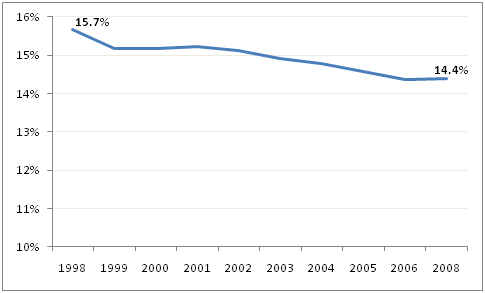 For the past thirty years, Washington State has been reducing the level of appropriations to higher education. In 1980-81, undergraduate tuition accounted for 25% of the total costs of undergraduate instruction in research universities, while the state covered the remaining 75%. By the 2007-08 academic year, tuition covered 62% and the state only 38%. The trend of disinvestment is also evident in community and technical colleges, with the state decreasing its share from 77% in 1980-81 to 58% in 2007-08.
For the past thirty years, Washington State has been reducing the level of appropriations to higher education. In 1980-81, undergraduate tuition accounted for 25% of the total costs of undergraduate instruction in research universities, while the state covered the remaining 75%. By the 2007-08 academic year, tuition covered 62% and the state only 38%. The trend of disinvestment is also evident in community and technical colleges, with the state decreasing its share from 77% in 1980-81 to 58% in 2007-08.
State Appropriations vs. Tuition as a Percentage of Costs of Instruction in Washington Research Universities

Source: Washington Higher Education Coordinating Board, “Key Facts About Higher Education in Washington”
Instead of fighting this retreat by the state, key leaders in public universities and colleges have given legislators an easy way to justify such cuts. The tradeoff that they offer is simple, and, for legislators, enticing: the less money you give us, the more we’ll raise tuition. This strategy has contributed to tuition in Washington escalating out of reach of many state residents. At all levels of public higher education, tuition has risen faster than both inflation and per capita income in the state since 1980.
Cumulative Percentage Increases in Washington Public Higher Education Tuition, Per Capita Income, and Inflation

Sources: Tuition data from Higher Education Coordinating Board; per capita income from Washington Office of Financial Management
The National Center for Public Policy and Higher Education’s study found that in 2008 the net college cost (tuition, room, and board minus financial aid) at Washington’s public four-year universities was 31% of the state’s average family income. For families in the bottom two quintiles, those costs equate to 45% of their incomes. Over the past 20 years the total cost (tuition, room, board, and expenses) of attending the University of Washington has grown from one fourth to nearly a third of the median household income for Washingtonians.
Total Costs of Attending University of Washington
as a percentage of median household income

Sources: University of Washington, Office of Institutional Research at UW and Washington Office of Financial Management
Even escalating tuition did not provide public colleges with sufficient revenues to maintain the same level of access for the state’s young adults. During the decade from 1998 to 2008, state-funded full-time equivalent enrollments at the state’s four-year public colleges fell relative to population growth, from 15.7% of the state’s 18- to 24-year olds to 14.4%.
State-Funded Full-Time Equivalent Enrollment in Public 4-Year Colleges and Universities
as a percentage of Washington population aged 18-34

Sources: Washington Office of Financial Management and Higher Education Coordinating Board
Tuition rates are set to rise even faster at Washington’s public colleges and universities over the next two academic years. The 2009-11 operating budget approved by the state legislature cut higher education funding by $617 million – or nearly 16% – from the amount needed to maintain the same level of services without tuition increases, given inflation and population growth.
Mark Emmert, president of the University of Washington, admitted that as a result “the university will have to switch to a much more market-driven model than it has in the past.” Indeed, Washington’s research universities will be increasing tuition prices by 30% over the next two years, while community colleges will be looking at increases of 15% over that same period.
Note: This is the second in a five-part series based on EOI’s latest report: Losing By Degrees. View part 1 here.
More To Read
May 2, 2024
Baby Bonds: A Step Toward Racial and Economic Equity
The Washington Future Fund would bring this innovative, anti-racist policy to the Evergreen State
May 1, 2024
Laws Targeting LGBTQ Youth Aren’t Just Bad for Kids – They’re Bad For The Economy
The harm done by anti-LGBTQ laws expands so much further than queer children and teens
April 26, 2024
What is WA Cares and Why Does It Matter for Washingtonians?
We need to defend this important policy from billionaires looking to save a buck
